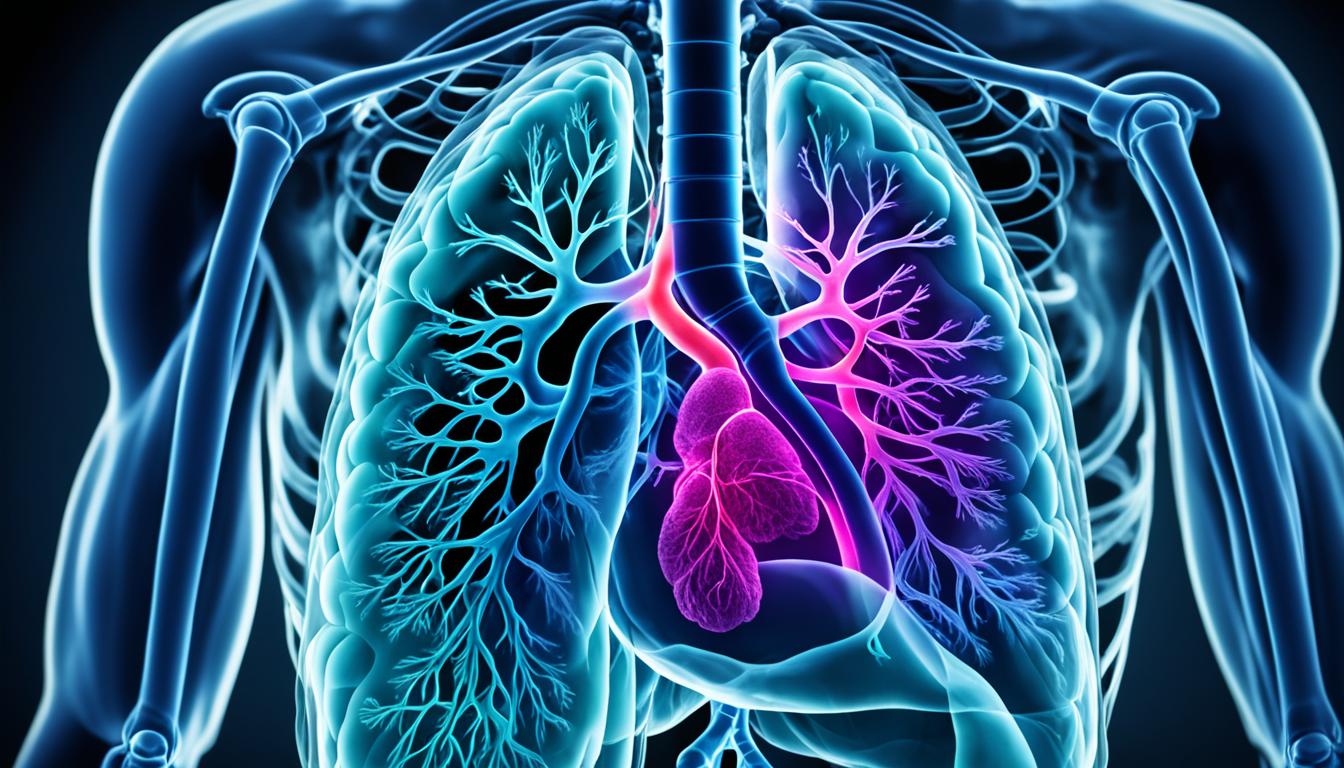Pulmonary fibrosis (PF) is a condition where the lungs scar over time. This scarring is caused by fibroblasts and extra material in the lung. It makes breathing difficult. We’re not sure exactly what causes PF, but things like smoking, viruses, and toxic substances can play a role. Idiopathic pulmonary fibrosis (IPF) is the most common type, and it has a serious outlook. Currently, treatment options are sparse, with lung transplants being the go-to for severe cases. Still, there’s hope in stem cell therapy. Stem cells can help repair lung damage and balance the immune system, presenting a new way to fight PF.
This piece looks into the warning signs, reasons, how it’s identified, and the latest on stem cell therapy for fibrosis interstitial pulmonary disease.
Key Takeaways:
- Fibrosis interstitial pulmonary disease is a chronic and progressive condition that leads to lung scarring and impaired respiratory function.
- The exact cause of the disease is unclear, but factors such as smoking, virus infections, and exposure to environmental toxins can contribute to its development.
- Idiopathic pulmonary fibrosis (IPF) is the most common form of lung fibrosis.
- Current treatment options for fibrosis interstitial pulmonary disease are limited, and lung transplantation is often the only option for advanced cases.
- Stem cell therapy offers a promising alternative for the treatment of fibrosis interstitial pulmonary disease, as it has the potential to regenerate damaged lung tissue and modulate the immune response.
Symptoms of Fibrosis Interstitial Pulmonary
The signs of lung fibrosis differ from person to person. Yet, there are common signs people may notice with fibrosis interstitial pulmonary disease:
- Breathing Difficulties: Those with lung fibrosis often find breathing hard, especially when active. This issue happens because their lungs get stiff and have scars that make getting oxygen tough.
- Persistent Cough: A long-lasting cough is a key sign of lung fibrosis. It can either be dry or bring up a little phlegm. This cough can be very annoying and make daily life tough.
- Fatigue: Feeling very tired or weak sticks with many lung fibrosis patients. It’s caused by not getting enough oxygen because their lungs don’t work well.
- Chest Pain: Chest pain is sometimes felt by those with lung fibrosis. The soreness might be sharp, dull, or tight. It might come with feeling uncomfortable too.
As lung fibrosis worsens, these symptoms get more severe and harm life quality. It’s key to catch and treat the condition early. This way, lives can be improved.
If these symptoms sound familiar, or you’re worried about your lungs, see a doctor. They can give you the right checkup and advice.
Causes and Risk Factors of Fibrosis Interstitial Pulmonary
Fibrosis interstitial pulmonary disease is complex and has many causes. Knowing these causes is crucial for stopping it early. Key factors include:
1. Smoking
Smoking greatly increases the risk of fibrosis interstitial pulmonary disease. It causes long-term lung inflammation and scarring. Quitting smoking lowers this risk and boosts your respiratory health.
2. Virus Infections
Virus infections, like COVID-19, play a part in fibrosis interstitial pulmonary disease. They can leave lasting lung damage that turns into fibrosis. To lower this risk, keep good hygiene and get medical help quickly if you get sick.
3. Environmental Toxins
Being around toxins in the environment can also lead to fibrosis. For instance, asbestos and silica harm the lungs. Proper safety at work and using protective gear is important to avoid these toxins.
4. Genetic Factors
Genes can make some people more likely to get this disease. Getting tested and counseling can show if you’re at high risk. This can help in creating a plan to prevent it.
5. Aging
Getting older is a risk for fibrosis interstitial pulmonary disease. As we age, our lung function can decline. This makes us more prone to lung problems like fibrosis. Keeping up with health checks and learning about lung health is crucial as we get older.
The image above visually depicts the risk factors associated with fibrosis interstitial pulmonary disease.
Stem Cell Therapy for Fibrosis Interstitial Pulmonary
Stem cell therapy brings hope to those with fibrosis interstitial pulmonary disease. It uses mesenchymal stem cells (MSCs) and pluripotent stem cells. Researchers hope to repair lung tissue with these cells.
MSCs can turn into many cell types. They release helpful factors that can adjust the immune response. This promotes lung healing and better breathing.
Pluripotent stem cells can become cells found in the lungs. They are perfect for fixing lung damage in fibrosis interstitial pulmonary patients. This is a key area of study.
Clinical trials show the promise of stem cell therapy. It appears safe and effective for this disease. Using the power of stem cells, researchers want to better the lives of those affected.

